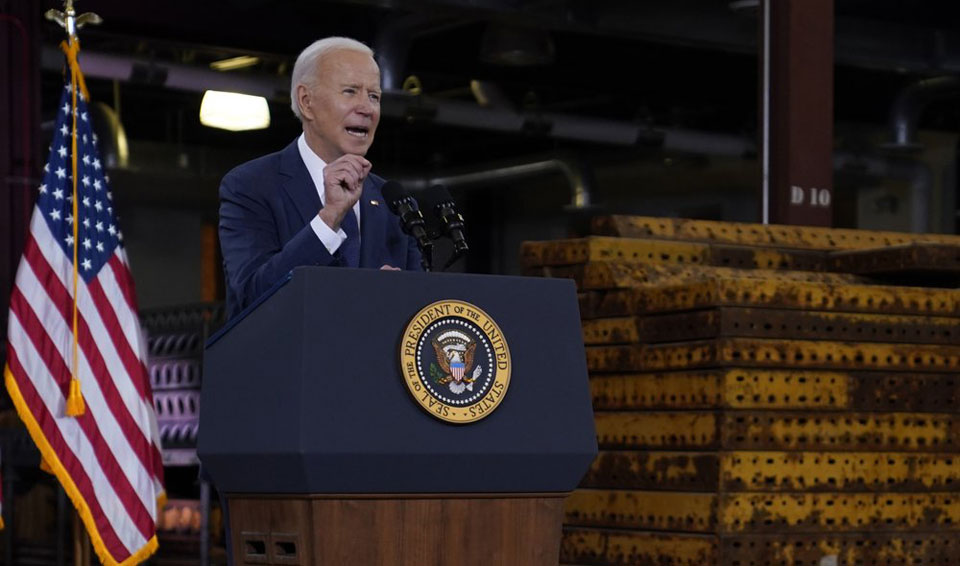
WASHINGTON—When you hear the word “infrastructure,” what do you think of?
Highways, bridges, railroads, airports, subways, water pipes, sewers, bus lines, and so on. All big projects and all built in past decades by male workers, many of them unionists.
President Joe Biden says isn’t thinking like that. His $2 trillion American Jobs Plan isn’t just a “guys’ jobs bill,” unlike past such legislation. It gives a big boost to women workers, too.
There are two big catches, though: One is the occupations that build the “big projects” in the bill are still male-dominated. Those are the ones congressional Republicans push while ignoring the woman workers, in teaching, child care, and other social service-oriented occupations, whom the infrastructure measure also helps.

The other is that Biden’s plan specifically calls for higher wages for workers in federally funded construction, through Project Labor Agreements. For the woman workers, there’s billions for child care workers. For both: Paid family and medical leave and backing unions, bypassing the Protect The Right To Organize Act, which would ease unionization for all workers.
The problem is that there’s a gender imbalance in construction, just as there’s one in education and social services. Labor Department jobs data show women are 11.9% of all building and construction inspectors. The rest are men, and 11.9% is the highest female share in that sector. Other building trades range from 0.3% female (masons) to 8.3% (painters). Unions say their members are one-sixth of all construction workers. DOL calculates 12.7% are.
By contrast, 94.8% of 928,000 U.S. child care workers are women. So are 90.3% of 571,000 home health care aides, 81.5% of 1.28 million personal care aides, and 77.5% of 4.87 million pre-K through 12th-grade teachers. Teachers unions say three-fourths of the teachers are members. DOL doesn’t publish separate data for union density for teachers.
The Administration says that Part II of its infrastructure plan is yet to be rolled out and that it will be the “family” part that really addresses the concerns of women.
People like Democratic Rep. Katie Porter of California have been saying that waiting until later for this is not good enough and that more of this should be part of this initial plan.
And in the 21st century, it is time to radically rethink things like daycare. What is needed is a massive program that provides children from the age of six months up to the age of 18 with a variety of services and programs that allow both mothers and fathers to take full time jobs.
Such an approach is one that will benefit everyone in our economy, people with and people without children. It would solve so many of the problems that plague society today and boost the economy through the production of millions of good jobs. We would end up with so many more productive youth and families in the workforce. A 21 st century approach to daycare would revitalize the economy in an unprecedented manner.
So it’s true that the Biden plan helps all genders, a point his new Labor Secretary, Marty Walsh, made in his first White House press briefing on April 2. But no one should lose sight that so much more is possible and necessary.
Walsh, a member of Laborers Local 223 in Boston and the city’s mayor before taking over DOL, is taking the administration’s message on the road. He’s one of five Cabinet members Biden told to get out in public and talk about both the jobs plan and the prior $1.9 trillion American Rescue law.
“Barriers to the labor force participation for women continue to be a problem that has been exposed and exasperated during this pandemic. We must continue to address the fact that working people and communities already suffering the most from inequality were hit the hardest during the COVID [coronavirus] illness and job loss,” Walsh said. “That’s why the American Jobs Plan…is so vital to our future. It tackles each of these issues head on and with bold action. The plan offers a necessary path forward towards sustainable economic growth that is robust, competitive, and inclusive.”
That path is at least $621 billion for the traditional infrastructure, with the PLAs. It’s also $100 billion to retrofit schools and $400 billion to rebuild and reopen child care facilities.
“As a former mayor, I know all about infrastructure needs. This plan would move us into the 21st century and to the forefront of the world in transportation, in clean energy, in high-speed Internet, and would create millions of good jobs” nationwide, Walsh said.
Walsh, as might be expected, said he was “thrilled” by the jobs plan, emphasizing its use of workers, their skills, and their opportunities while strengthening the right to organize.
The jobs plan’s “investments will create and open up access to good manufacturing and construction jobs. There’s also a major investment in our caring professionals, in an industry where one in six workers–who are disproportionately women of color–live in poverty. We’ve seen how much our families depend on childcare and seniors care over the last year. Those skilled, compassionate workers need and deserve a better deal,” he declared.
That’s where Biden’s plan actually does differ from past infrastructure bills. It would “solidify the infrastructure of our care economy by creating jobs and raising wages and benefits for essential home care workers,” an administration fact sheet says.
“These workers–the majority of whom are women of color–have been underpaid and undervalued for too long. The plan makes substantial investments in the infrastructure of our care economy, starting by creating new and better jobs for caregiving workers. His plan will provide home and community-based care for individuals who otherwise would need to wait as many as five years to get the services they badly need,” the fact sheet adds.
Union leaders understand that. After lauding Biden’s commitment of $100 billion to retrofitting and upgrading school buildings—“guy” jobs for the building trades—Teachers (AFT) President Randi Weingarten joyfully cited the $400 billion for child care and home care.
“More than just a plan to fix buildings, this plan reflects a deep understanding of the pain and obstacles families face—whether they are poor or middle class—and the aspirations we all have for our children and our families,” New York City civics teacher Weingarten said.
“Biden plans to invest in our nation’s care infrastructure by addressing our most pressing social challenges, ensuring there are high-quality union jobs throughout the economy, and providing a better and fairer society for all Americans.”
Biden’s plan “does more than create good-paying union jobs,” added Becky Pringle, the Philadelphia science teacher who heads the nation’s largest union, the 3.2-million-member National Education Association.
“It also invests in housing, childcare, and safe water infrastructure that focuses on neglected communities. And, by investing in public schools, the beating heart of every community, President Biden’s bold plan will power America’s economic recovery and pay dividends down the road.”
“A jobs program has never been focused on an industry primarily composed of women of color,” added Service Employees President Mary Kay Henry, whose union represents tens of thousands of home health care and similar workers, and is organizing more. “President Biden has clearly heard the demand of these women—and millions of other essential workers—to be respected, protected, and paid.”
As for the other big woman-dominated occupation—in bars and restaurants—Biden’s past $1.9 trillion rescue plan, including more long-term forgivable federal loans to small businesses, is supposed to help them. There are many to help: 301,000 bartenders, 51% male, and 1.39 million restaurant servers, 70% female. The catch is whether the eating and drinking places they once toiled at reopen—and what wages they’d get paid if they do.
But the workers need it, too. Though 175,800 of those workers returned to those jobs in March, the industry as a whole employs 1.172 million fewer people than it did a year before.
And Unite Here, which represents hundreds of thousands of those workers, reported that at one point, 95% of its members, who also include hotel and motel staffers, were out of jobs when the travel industry collapsed due to the pandemic. It has yet to comment on Biden’s infrastructure proposal.
The GOP is, as usual, tone-deaf to woman workers, living back in the 1950s or before.
“Less than 6% of this massive proposal goes to roads and bridges. It would spend more money just on electric cars than on America’s roads, bridges, ports, airports, and waterways combined,” Senate GOP leader Mitch McConnell, R-Ky., snidely, and inaccurately, charged.
Dragging out worn Republican stereotypes, McConnell charged Biden’s bill “contains sweeping far-left priorities like attacking blue-collar Americans’ Right to Work protections, a huge favor to Big Labor bosses (his capitalization). Every time that far-left dogma clashes with the interests of American families, today’s Democrats pick the dogma.”

McConnell said not a word about helping woman workers, in child care, schools, or anywhere else. He did promise “not one [Senate] Republican” would vote for it.
The notoriously anti-worker Associated Builders and Contractors complained about “divisive government-mandated” Project Labor Agreements, while not mentioning PLAs guarantee good pay—not necessarily union wage, but set to local wage rates—for construction workers in return for fair labor standards and treatment on job sites.
ABC, too, had zip to say about helping woman workers. It has one nod to women in construction: A 1-day summit on “inclusion, diversity and equity,” planned for June 14.
John Wojcik contributed to this story.












Comments